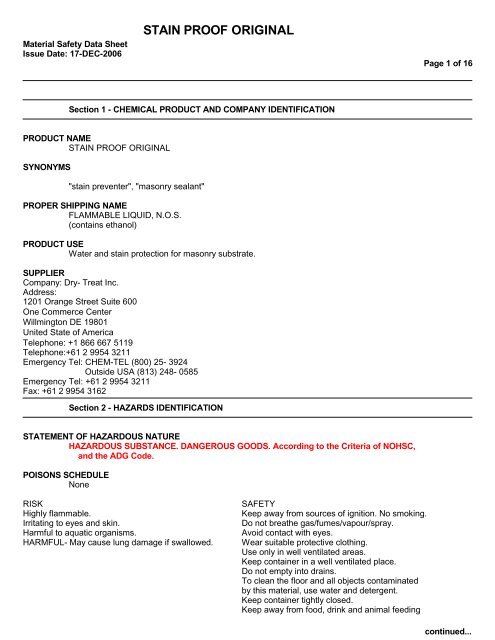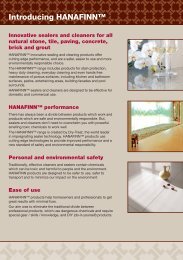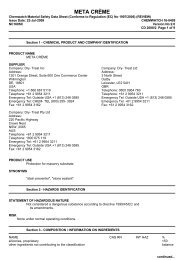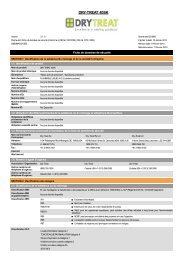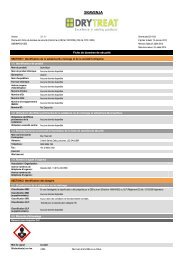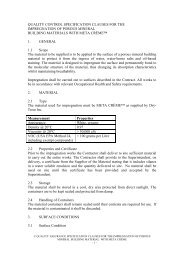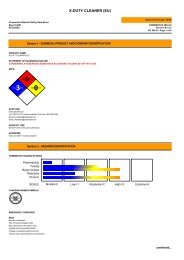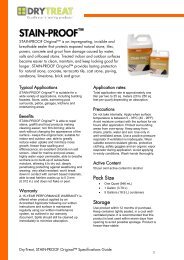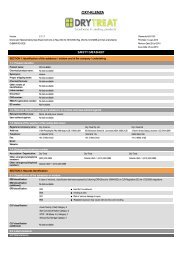Stain proof original - Dry Treat
Stain proof original - Dry Treat
Stain proof original - Dry Treat
Create successful ePaper yourself
Turn your PDF publications into a flip-book with our unique Google optimized e-Paper software.
Material Safety Data Sheet<br />
Issue Date: 17-DEC-2006<br />
STAIN PROOF ORIGINAL<br />
Section 1 - CHEMICAL PRODUCT AND COMPANY IDENTIFICATION<br />
PRODUCT NAME<br />
STAIN PROOF ORIGINAL<br />
SYNONYMS<br />
"stain preventer", "masonry sealant"<br />
PROPER SHIPPING NAME<br />
FLAMMABLE LIQUID, N.O.S.<br />
(contains ethanol)<br />
PRODUCT USE<br />
Water and stain protection for masonry substrate.<br />
SUPPLIER<br />
Company: <strong>Dry</strong>- <strong>Treat</strong> Inc.<br />
Address:<br />
1201 Orange Street Suite 600<br />
One Commerce Center<br />
Willmington DE 19801<br />
United State of America<br />
Telephone: +1 866 667 5119<br />
Telephone:+61 2 9954 3211<br />
Emergency Tel: CHEM-TEL (800) 25- 3924<br />
Outside USA (813) 248- 0585<br />
Emergency Tel: +61 2 9954 3211<br />
Fax: +61 2 9954 3162<br />
Section 2 - HAZARDS IDENTIFICATION<br />
STATEMENT OF HAZARDOUS NATURE<br />
HAZARDOUS SUBSTANCE. DANGEROUS GOODS. According to the Criteria of NOHSC,<br />
and the ADG Code.<br />
POISONS SCHEDULE<br />
None<br />
RISK SAFETY<br />
Highly flammable. Keep away from sources of ignition. No smoking.<br />
Irritating to eyes and skin. Do not breathe gas/fumes/vapour/spray.<br />
Harmful to aquatic organisms. Avoid contact with eyes.<br />
HARMFUL- May cause lung damage if swallowed. Wear suitable protective clothing.<br />
Use only in well ventilated areas.<br />
Keep container in a well ventilated place.<br />
Do not empty into drains.<br />
To clean the floor and all objects contaminated<br />
by this material, use water and detergent.<br />
Keep container tightly closed.<br />
Keep away from food, drink and animal feeding<br />
Page 1 of 16<br />
continued...
Material Safety Data Sheet<br />
Issue Date: 17-DEC-2006<br />
STAIN PROOF ORIGINAL<br />
Section 3 - COMPOSITION / INFORMATION ON INGREDIENTS<br />
Page 2 of 16<br />
Section 2 - HAZARDS IDENTIFICATION<br />
stuffs.<br />
Take off immediately all contaminated clothing.<br />
In case of contact with eyes, rinse with plenty<br />
of water and contact Doctor or Poisons<br />
Information Centre.<br />
If swallowed, IMMEDIATELY contact Doctor or<br />
Poisons Information Centre. (show this container<br />
or label).<br />
This material and its container must be disposed<br />
of as hazardous waste.<br />
NAME CAS RN %<br />
ethanol 64-17-5 30-60<br />
alkylalkoxysilane 20-40<br />
isopropyl acetate 108-21-4 1-10<br />
additives nonhazardous 1-10<br />
Section 4 - FIRST AID MEASURES<br />
SWALLOWED<br />
If spontaneous vomiting appears imminent or occurs, hold patient's head down, lower than<br />
their hips to help avoid possible aspiration of vomitus.<br />
- If swallowed do NOT induce vomiting.<br />
- If vomiting occurs, lean patient forward or place on left side (head-down position, if<br />
possible) to maintain open airway and prevent aspiration.<br />
- Observe the patient carefully.<br />
- Never give liquid to a person showing signs of being sleepy or with reduced awareness;<br />
i.e. becoming unconscious.<br />
- Give water to rinse out mouth, then provide liquid slowly and as much as casualty can<br />
comfortably drink.<br />
- Seek medical advice.<br />
EYE<br />
SKIN<br />
If this product comes in contact with the eyes:<br />
- Immediately hold eyelids apart and flush the eye continuously with running water.<br />
- Ensure complete irrigation of the eye by keeping eyelids apart and away from eye and<br />
moving the eyelids by occasionally lifting the upper and lower lids.<br />
- Continue flushing until advised to stop by the Poisons Information Centre or a doctor,<br />
or for at least 15 minutes.<br />
- Transport to hospital or doctor without delay.<br />
- Removal of contact lenses after an eye injury should only be undertaken by skilled<br />
personnel.<br />
If skin contact occurs:<br />
- Immediately remove all contaminated clothing, including footwear<br />
- Flush skin and hair with running water (and soap if available).<br />
- Seek medical attention in event of irritation.<br />
continued...
Material Safety Data Sheet<br />
Issue Date: 17-DEC-2006<br />
INHALED<br />
STAIN PROOF ORIGINAL<br />
Page 3 of 16<br />
Section 4 - FIRST AID MEASURES<br />
- If fumes or combustion products are inhaled remove from contaminated area.<br />
- Lay patient down. Keep warm and rested.<br />
- Prostheses such as false teeth, which may block airway, should be removed, where<br />
possible, prior to initiating first aid procedures.<br />
- Apply artificial respiration if not breathing, preferably with a demand valve<br />
resuscitator, bag-valve mask device, or pocket mask as trained. Perform CPR if necessary.<br />
- Transport to hospital, or doctor.<br />
NOTES TO PHYSICIAN<br />
Any material aspirated during vomiting may produce lung injury. Therefore emesis should<br />
not be induced mechanically or pharmacologically. Mechanical means should be used if it<br />
is considered necessary to evacuate the stomach contents; these include gastric lavage<br />
after endotracheal intubation. If spontaneous vomiting has occurred after ingestion, the<br />
patient should be monitored for difficult breathing, as adverse effects of aspiration<br />
into the lungs may be delayed up to 48 hours.<br />
For acute or short term repeated exposures to ethanol:<br />
- Acute ingestion in non-tolerant patients usually responds to supportive care with<br />
special attention to prevention of aspiration, replacement of fluid and correction of<br />
nutritional deficiencies (magnesium, thiamine pyrodoxine, Vitamins C K)<br />
- Give 50% dextrose (50-100 ml) IV to obtunded patients following blood draw for glucose<br />
determination.<br />
- Comatose patients should be treated with initial attention to airway, breathing,<br />
circulation and drugs of immediate importance (glucose, thiamine)<br />
- Decontamination is probably unnecessary more than 1 hour after a single observed<br />
ingestion. Cathartics and charcoal may be given but are probably not effective in single<br />
ingestions.<br />
- Fructose administration is contra-indicated due to side effects.<br />
Section 5 - FIRE FIGHTING MEASURES<br />
EXTINGUISHING MEDIA<br />
- Alcohol stable foam.<br />
- <strong>Dry</strong> chemical powder.<br />
- BCF (where regulations permit).<br />
- Carbon dioxide.<br />
- Water spray or fog - Large fires only.<br />
FIRE FIGHTING<br />
- Alert Fire Brigade and tell them location and nature of hazard.<br />
- May be violently or explosively reactive.<br />
- Wear breathing apparatus plus protective gloves.<br />
- Prevent, by any means available, spillage from entering drains or water course.<br />
- Consider evacuation (or protect in place).<br />
- Fight fire from a safe distance, with adequate cover.<br />
- If safe, switch off electrical equipment until vapour fire hazard removed.<br />
- Use water delivered as a fine spray to control the fire and cool adjacent area.<br />
- Avoid spraying water onto liquid pools.<br />
- Do not approach containers suspected to be hot.<br />
- Cool fire exposed containers with water spray from a protected location.<br />
- If safe to do so, remove containers from path of fire.<br />
When any large container (including road and rail tankers) is involved in a fire,<br />
continued...
Material Safety Data Sheet<br />
Issue Date: 17-DEC-2006<br />
STAIN PROOF ORIGINAL<br />
consider evacuation by 500 metres in all directions.<br />
FIRE/EXPLOSION HAZARD<br />
- Liquid and vapour are highly flammable.<br />
- Severe fire hazard when exposed to heat, flame and/or oxidisers.<br />
- Vapour may travel a considerable distance to source of ignition.<br />
- Heating may cause expansion or decomposition leading to violent rupture of containers.<br />
- On combustion, may emit toxic fumes of carbon monoxide (CO).<br />
Combustion products include: carbon dioxide (CO2), formaldehyde, hydrogen fluoride,<br />
silicon dioxide (SiO2), other pyrolysis products typical of burning organic<br />
material.<br />
FIRE INCOMPATIBILITY<br />
Avoid contamination with oxidising agents i.e. nitrates, oxidising acids, chlorine<br />
bleaches, pool chlorine etc. as ignition may result.<br />
HAZCHEM: 3[Y]E<br />
Personal Protective Equipment<br />
Breathing apparatus.<br />
Chemical splash suit.<br />
Section 6 - ACCIDENTAL RELEASE MEASURES<br />
EMERGENCY PROCEDURES<br />
MINOR SPILLS<br />
- Remove all ignition sources.<br />
- Clean up all spills immediately.<br />
- Avoid breathing vapours and contact with skin and eyes.<br />
- Control personal contact by using protective equipment.<br />
- Contain and absorb small quantities with vermiculite or other absorbent material.<br />
- Wipe up.<br />
- Collect residues in a flammable waste container.<br />
MAJOR SPILLS<br />
- Clear area of personnel and move upwind.<br />
- Alert Fire Brigade and tell them location and nature of hazard.<br />
- May be violently or explosively reactive.<br />
- Wear breathing apparatus plus protective gloves.<br />
- Prevent, by any means available, spillage from entering drains or water course.<br />
- Consider evacuation (or protect in place).<br />
- No smoking, naked lights or ignition sources.<br />
- Increase ventilation.<br />
- Stop leak if safe to do so.<br />
- Water spray or fog may be used to disperse /absorb vapour.<br />
- Contain spill with sand, earth or vermiculite.<br />
- Use only spark-free shovels and explosion <strong>proof</strong> equipment.<br />
- Collect recoverable product into labelled containers for recycling.<br />
- Absorb remaining product with sand, earth or vermiculite.<br />
- Collect solid residues and seal in labelled drums for disposal.<br />
- Wash area and prevent runoff into drains.<br />
- If contamination of drains or waterways occurs, advise emergency services.<br />
Page 4 of 16<br />
Section 5 - FIRE FIGHTING MEASURES<br />
continued...
Material Safety Data Sheet<br />
Issue Date: 17-DEC-2006<br />
STAIN PROOF ORIGINAL<br />
PROTECTIVE ACTIONS FOR SPILL<br />
PROTECTIVE ACTION ZONE<br />
wind<br />
direction<br />
INITIAL<br />
ISOLATION<br />
ZONE<br />
isolation<br />
distance<br />
evacuation<br />
direction<br />
down wind distance<br />
evacuation<br />
direction<br />
From IERG (Canada/Australia)<br />
Isolation Distance 25 metres<br />
Downwind Protection Distance 300 metres<br />
IERG Number 14<br />
half<br />
downwind<br />
distance<br />
half<br />
downwind<br />
distance<br />
Page 5 of 16<br />
Section 6 - ACCIDENTAL RELEASE MEASURES<br />
FOOTNOTES<br />
1 PROTECTIVE ACTION ZONE is defined as the area in which people are at risk of harmful exposure. This zone<br />
assumes that random changes in wind direction confines the vapour plume to an area within 30 degrees on<br />
either side of the predominant wind direction, resulting in a crosswind protective action distance equal<br />
to the downwind protective action distance.<br />
2 PROTECTIVE ACTIONS should be initiated to the extent possible, beginning with those closest to the spill<br />
and working away from the site in the downwind direction. Within the protective action zone a level of<br />
vapour concentration may exist resulting in nearly all unprotected persons becoming incapacitated and<br />
unable to take protective action and/or incurring serious or irreversible health effects.<br />
3 INITIAL ISOLATION ZONE is determined as an area, including upwind of the incident, within which a high<br />
probability of localised wind reversal may expose nearly all persons without appropriate protection to<br />
life-threatening concentrations of the material.<br />
4 SMALL SPILLS involve a leaking package of 200 litres (55 US gallons) or less, such as a drum (jerrican or<br />
box with inner containers). Larger packages leaking less than 200 litres and compressed gas leaking from<br />
a small cylinder are also considered "small spills".<br />
LARGE SPILLS involve many small leaking packages or a leaking package of greater than 200 litres, such as<br />
a cargo tank, portable tank or a "one-tonne" compressed gas cylinder.<br />
5 Guide 128 is taken from the US DOT emergency response guide book.<br />
6 IERG information is derived from CANUTEC - Transport Canada.<br />
EMERGENCY RESPONSE PLANNING GUIDELINES (ERPG)<br />
The maximum airborne concentration below which it is believed that nearly all individuals could be exposed<br />
for up to one hour WITHOUT experiencing or developing<br />
life-threatening health effects is:<br />
ethanol 3300 ppm<br />
isopropyl acetate 1800 ppm<br />
irreversible or other serious effects or symptoms which could impair an individual's ability to take<br />
protective action is:<br />
ethanol 3300 ppm<br />
isopropyl acetate 310 ppm<br />
continued...
Material Safety Data Sheet<br />
Issue Date: 17-DEC-2006<br />
STAIN PROOF ORIGINAL<br />
other than mild, transient adverse effects without perceiving a clearly defined odour is:<br />
ethanol 3000 ppm<br />
isopropyl acetate 310 ppm<br />
Page 6 of 16<br />
Section 6 - ACCIDENTAL RELEASE MEASURES<br />
The threshold concentration below which most people will experience no appreciable risk of health effects:<br />
ethanol 1000 ppm<br />
isopropyl acetate 250 ppm<br />
American Industrial Hygiene Association (AIHA)<br />
Ingredients considered according to the following cutoffs<br />
Very Toxic (T+) >= 0.1% Toxic (T) >= 3.0%<br />
R50 >= 0.25% Corrosive (C) >= 5.0%<br />
R51 >= 2.5%<br />
else >= 10%<br />
where percentage is percentage of ingredient found in the mixture<br />
Personal Protective Equipment advice is contained in Section 8 of the MSDS.<br />
Section 7 - HANDLING AND STORAGE<br />
PROCEDURE FOR HANDLING<br />
- Containers, even those that have been emptied, may contain explosive vapours.<br />
- Do NOT cut, drill, grind, weld or perform similar operations on or near containers.<br />
DO NOT allow clothing wet with material to stay in contact with skin.<br />
- Avoid all personal contact, including inhalation.<br />
- Wear protective clothing when risk of exposure occurs.<br />
- Use in a well-ventilated area.<br />
- Prevent concentration in hollows and sumps.<br />
- DO NOT enter confined spaces until atmosphere has been checked.<br />
- Avoid smoking, naked lights, heat or ignition sources.<br />
- When handling, DO NOT eat, drink or smoke.<br />
- Vapour may ignite on pumping or pouring due to static electricity.<br />
- DO NOT use plastic buckets.<br />
- Earth and secure metal containers when dispensing or pouring product.<br />
- Use spark-free tools when handling.<br />
- Avoid contact with incompatible materials.<br />
- Keep containers securely sealed.<br />
- Avoid physical damage to containers.<br />
- Always wash hands with soap and water after handling.<br />
- Work clothes should be laundered separately.<br />
- Use good occupational work practice.<br />
- Observe manufacturer's storing and handling recommendations.<br />
- Atmosphere should be regularly checked against established exposure standards to<br />
ensure safe working conditions.<br />
SUITABLE CONTAINER<br />
Packing as supplied by manufacturer. Plastic containers may only be used if approved for<br />
flammable liquid. Check that containers are clearly labelled and free from leaks.<br />
- For low viscosity materials (i) : Drums and jerry cans must be of the non-removable<br />
head type. (ii) : Where a can is to be used as an inner package, the can must have a<br />
screwed enclosure.<br />
continued...
Material Safety Data Sheet<br />
Issue Date: 17-DEC-2006<br />
STAIN PROOF ORIGINAL<br />
Page 7 of 16<br />
Section 7 - HANDLING AND STORAGE<br />
- For materials with a viscosity of at least 2680 cSt. (23 deg. C)<br />
- For manufactured product having a viscosity of at least 250 cSt. (23 deg. C)<br />
- Manufactured product that requires stirring before use and having a viscosity of at<br />
least 20 cSt (25 deg. C)<br />
(i) : Removable head packaging;<br />
(ii) : Cans with friction closures and<br />
(iii) : low pressure tubes and cartridges may be used.<br />
- Where combination packages are used, and the inner packages are of glass, there must be<br />
sufficient inert cushioning material in contact with inner and outer packages<br />
- In addition, where inner packagings are glass and contain liquids of packing group I<br />
there must be sufficient inert absorbent to absorb any spillage, unless the outer<br />
packaging is a close fitting moulded plastic box and the substances are not incompatible<br />
with the plastic.<br />
STORAGE INCOMPATIBILITY<br />
Avoid strong bases.<br />
Incompatible with aluminium. DO NOT heat above 49 deg. C. in aluminium equipment.<br />
- Avoid oxidising agents, acids, acid chlorides, acid anhydrides.<br />
STORAGE REQUIREMENTS<br />
- Store in <strong>original</strong> containers in approved flame-<strong>proof</strong> area.<br />
- No smoking, naked lights, heat or ignition sources.<br />
- DO NOT store in pits, depressions, basements or areas where vapours may be trapped.<br />
- Keep containers securely sealed.<br />
- Store away from incompatible materials in a cool, dry well ventilated area.<br />
- Protect containers against physical damage and check regularly for leaks.<br />
- Observe manufacturer's storing and handling recommendations.<br />
Section 8 - EXPOSURE CONTROLS / PERSONAL PROTECTION<br />
EXPOSURE CONTROLS<br />
Source Material TWA TWA STEL STEL Peak Peak TWA<br />
ppm mg/m³ ppm mg/m³ ppm mg/m³ F/CC<br />
_________________ __________________ ______ ______ ______ ______ ______ ______ ______<br />
Australia Exposure ethanol (Ethyl 1, 000 1, 880<br />
Standards alcohol)<br />
Australia Exposure isopropyl acetate 250 1040 310 1, 290<br />
Standards (Isopropyl<br />
acetate)<br />
The following materials had no OELs on our record under the following CAS<br />
• <strong>Dry</strong>-<strong>Treat</strong> <strong>Stain</strong> Proof (Aust.):<br />
EMERGENCY EXPOSURE LIMITS<br />
Material Revised IDLH Value Revised IDLH Value<br />
(mg/m3) (ppm)<br />
ethanol 3, 300 [LEL]<br />
isopropyl acetate 1, 800<br />
NOTES<br />
Values marked LEL indicate that the IDLH was based on 10% of the lower explosive limit<br />
continued...
Material Safety Data Sheet<br />
Issue Date: 17-DEC-2006<br />
STAIN PROOF ORIGINAL<br />
for safety considerations even though the relevant toxicological data indicated that<br />
irreversible health effects or impairment of escape existed only at higher<br />
concentrations.<br />
Page 8 of 16<br />
Section 8 - EXPOSURE CONTROLS / PERSONAL PROTECTION<br />
ODOUR SAFETY FACTOR (OSF)<br />
OSF=6 (ETHANOL)<br />
Exposed individuals are NOT reasonably expected to be warned, by smell, that the Exposure Standard is being exceede<br />
Odour Safety Factor (OSF) is determined to fall into either Class C, D or E.<br />
The Odour Safety Factor (OSF) is defined as:<br />
OSF= Exposure Standard (TWA) ppm/ Odour Threshold Value (OTV) ppm<br />
Classification into classes follows:<br />
Class OSF Description<br />
A 550 Over 90% of exposed<br />
individuals are aware by smell<br />
that the Exposure Standard<br />
(TLV- TWA for example) is<br />
being reached, even when<br />
distracted by working<br />
activities<br />
B 26- 550 As " A" for 50- 90% of persons<br />
being distracted<br />
C 1- 26 As " A" for less than 50% of<br />
persons being distracted<br />
D 0.18- 1 10- 50% of persons aware of<br />
being tested perceive by smell<br />
that the Exposure Standard is<br />
being reached<br />
E
Material Safety Data Sheet<br />
Issue Date: 17-DEC-2006<br />
15 minutes experienced eye irritation.<br />
PERSONAL PROTECTION<br />
STAIN PROOF ORIGINAL<br />
Page 9 of 16<br />
Section 8 - EXPOSURE CONTROLS / PERSONAL PROTECTION<br />
EYE<br />
- Safety glasses with side shields.<br />
- Chemical goggles.<br />
- Contact lenses may pose a special hazard; soft contact lenses may absorb and<br />
concentrate irritants. A written policy document, describing the wearing of lens or<br />
restrictions on use, should be created for each workplace or task. This should include a<br />
review of lens absorption and adsorption for the class of chemicals in use and an account<br />
of injury experience. Medical and first-aid personnel should be trained in their removal<br />
and suitable equipment should be readily available. In the event of chemical exposure,<br />
begin eye irrigation immediately and remove contact lens as soon as practicable. Lens<br />
should be removed at the first signs of eye redness or irritation - lens should be<br />
removed in a clean environment only after workers have washed hands thoroughly. [CDC<br />
NIOSH Current Intelligence Bulletin 59].<br />
HANDS/FEET<br />
Suitability and durability of glove type is dependent on usage. Factors such as:<br />
- frequency and duration of contact,<br />
- chemical resistance of glove material,<br />
- glove thickness and<br />
- dexterity,<br />
are important in the selection of gloves.<br />
Wear chemical protective gloves, eg. PVC.<br />
Wear safety footwear or safety gumboots, eg. Rubber.<br />
OTHER<br />
- Overalls.<br />
- PVC Apron.<br />
- PVC protective suit may be required if exposure severe.<br />
- Eyewash unit.<br />
- Ensure there is ready access to a safety shower.<br />
RESPIRATOR<br />
Selection of the Class and Type of respirator will depend upon the level of breathing<br />
zone contaminant and the chemical nature of the contaminant. Protection Factors (defined<br />
as the ratio of contaminant outside and inside the mask) may also be important.<br />
Breathing Zone Level Maximum Protection Half- face Respirator Full- Face Respirator<br />
ppm (volume) Factor<br />
1000 10 A- AUS -<br />
1000 50 - A- AUS<br />
5000 50 Airline * -<br />
5000 100 - A- 2<br />
10000 100 - A- 3<br />
100+ Airline**<br />
* - Continuous Flow ** - Continuous-flow or positive pressure demand.<br />
The local concentration of material, quantity and conditions of use determine the type of<br />
personal protective equipment required.<br />
For further information consult site specific<br />
CHEMWATCH data (if available), or your<br />
continued...
Material Safety Data Sheet<br />
Issue Date: 17-DEC-2006<br />
Occupational Health and Safety Advisor.<br />
STAIN PROOF ORIGINAL<br />
Page 10 of 16<br />
Section 8 - EXPOSURE CONTROLS / PERSONAL PROTECTION<br />
ENGINEERING CONTROLS<br />
For flammable liquids and flammable gases, local exhaust ventilation or a process<br />
enclosure ventilation system may be required. Ventilation equipment should be explosion<br />
-resistant.<br />
Section 9 - PHYSICAL AND CHEMICAL PROPERTIES<br />
APPEARANCE<br />
Clear yellow flammable liquid with an ester- like odour. Not miscible with water, partial<br />
decomposition by hydrolysis.<br />
PHYSICAL PROPERTIES<br />
Does not mix with water.<br />
Floats on water.<br />
Molecular Weight: Not applicable Boiling Range (°C): Not av ailable<br />
Melting Range (°C): Not available Specific Gravity (water= 1): 0.81<br />
Solubility in water (g/L): Immiscible pH (as supplied): Not Applicable<br />
pH (1% solution): Not Applicable Vapour Pressure (kPa): Not available<br />
Volatile Component (%vol): Not available Evaporation Rate: Not available<br />
Relative Vapour Density (air=1): Not available Flash Point (°C): 13 (CC)<br />
Lower Explosive Limit (%): Not available Upper Explosive Limit (%): Not available<br />
Autoignition Temp (°C): Not available Decomposition Temp ( °C): Not Available<br />
State: LIQUID Viscosity: Not Available<br />
Section 10 - CHEMICAL STABILITY AND REACTIVITY INFORMATION<br />
CONDITIONS CONTRIBUTING TO INSTABILITY<br />
- Presence of incompatible materials.<br />
- Product is considered stable.<br />
- Hazardous polymerisation will not occur.<br />
Section 11 - TOXICOLOGICAL INFORMATION<br />
POTENTIAL HEALTH EFFECTS<br />
ACUTE HEALTH EFFECTS<br />
SWALLOWED<br />
Accidental ingestion of the material may be damaging to the health of the individual.<br />
Swallowing of the liquid may cause aspiration into the lungs with the risk of chemical<br />
pneumonitis; serious consequences may result.<br />
(ICSC13733).<br />
Ingestion of ethanol may produce nausea, vomiting, gastrointestinal bleeding, abdominal<br />
pain and diarrhoea. Systemic effects:<br />
continued...
Material Safety Data Sheet<br />
Issue Date: 17-DEC-2006<br />
STAIN PROOF ORIGINAL<br />
Page 11 of 16<br />
Section 11 - TOXICOLOGICAL INFORMATION<br />
Blood concentration: Effects:<br />
Material Safety Data Sheet<br />
Issue Date: 17-DEC-2006<br />
STAIN PROOF ORIGINAL<br />
(vesiculation), scaling and thickening of the epidermis. At the microscopic level there<br />
may be intercellular oedema of the spongy layer of the skin (spongiosis) and<br />
intracellular oedema of the epidermis.<br />
Entry into the blood-stream, through, for example, cuts, abrasions or lesions, may<br />
produce systemic injury with harmful effects. Examine the skin prior to the use of the<br />
material and ensure that any external damage is suitably protected.<br />
Page 12 of 16<br />
Section 11 - TOXICOLOGICAL INFORMATION<br />
INHALED<br />
Inhalation hazard is increased at higher temperatures.<br />
Acute effects from inhalation of high concentrations of vapour are pulmonary irritation,<br />
including coughing, with nausea; central nervous system depression - characterised by<br />
headache and dizziness, increased reaction time, fatigue and loss of co-ordination.<br />
If exposure to highly concentrated solvent atmosphere is prolonged this may lead to<br />
narcosis, unconsciousness, even coma and possible death.<br />
The most common signs of inhalation overexposure to ethanol, in animals, include ataxia,<br />
incoordination and drowsiness for those surviving narcosis. The narcotic dose for rats,<br />
after 2 hours of exposure, is 19260 ppm.<br />
CHRONIC HEALTH EFFECTS<br />
Limited evidence suggests that repeated or long-term occupational exposure may produce<br />
cumulative health effects involving organs or biochemical systems.<br />
Long-term exposure to ethanol may result in progressive liver damage with fibrosis or may<br />
exacerbate liver injury caused by other agents.<br />
Repeated ingestion of ethanol by pregnant women may adversely affect the central nervous<br />
system of the developing fetus, producing effects collectively described as fetal alcohol<br />
syndrome. These include mental and physical retardation, learning disturbances, motor and<br />
language deficiency, behavioural disorders and reduced head size.<br />
Consumption of ethanol (in alcoholic beverages) may be linked to the development of Type<br />
I hypersensitivities in a small number of individuals. Symptoms, which may appear<br />
immediately after consumption, include conjunctivitis, angioedema, dyspnoea, and<br />
urticarial rashes. The causative agent may be acetic acid, a metabolite (1).<br />
(1) Boehncke W.H., & H.Gall, Clinical & Experimental Allergy, 26, 1089-1091, 1996.<br />
Chronic solvent inhalation exposures may result in nervous system impairment<br />
and liver and blood changes. [PATTYS].<br />
TOXICITY AND IRRITATION<br />
Not available. Refer to individual constituents.<br />
unless otherwise specified data extracted from RTECS - Register of Toxic Effects of<br />
Chemical Substances<br />
ETHANOL:<br />
TOXICITY IRRITATION<br />
Oral (rat) LD50: 7060 mg/kg Skin (rabbit):20 mg/24hr- Moderate<br />
Oral (human) LDLo: 1400 mg/kg Skin (rabbit):400 mg (open)- Mild<br />
Oral (man) TDLo: 50 mg/kg Eye (rabbit):100mg/24hr- Moderate<br />
Oral (man) TDLo: 1.40 mg/kg Eye (rabbit): 500 mg SEVERE<br />
Oral (woman) TDLo: 256 mg/kg/12 wks<br />
Inhalation (rat) LC50: 20, 000 ppm/10h<br />
Inhalation (rat) LC50: 64000 ppm/4h<br />
ISOPROPYL ACETATE:<br />
TOXICITY IRRITATION<br />
continued...
Material Safety Data Sheet<br />
Issue Date: 17-DEC-2006<br />
STAIN PROOF ORIGINAL<br />
Page 13 of 16<br />
Section 11 - TOXICOLOGICAL INFORMATION<br />
Inhalation (rat) LC50: 50600 mg/m³/8h Eye (human): 200 ppm/15m<br />
Oral (rabbit) LD50: 6946 mg/kg Skin (rabbit): 500 mg/24h - Mild<br />
Dermal (rabbit) LD50: >20000 mg/kg Eye (rabbit): 500 mg Open<br />
Eye (rabbit): 500 mg/24h - Mild<br />
The material may be irritating to the eye, with prolonged contact causing inflammation.<br />
Repeated or prolonged exposure to irritants may produce conjunctivitis.<br />
The material may cause skin irritation after prolonged or repeated exposure and may<br />
produce a contact dermatitis (nonallergic). This form of dermatitis is often<br />
characterised by skin redness (erythema) and swelling epidermis. Histologically there may<br />
be intercellular oedema of the spongy layer (spongiosis) and intracellular oedema of the<br />
epidermis.<br />
MATERIAL CARCINOGEN REPROTOXIN SENSITISER SKIN<br />
________________________ ____________________ ________________ ________________ ________________<br />
ethanol ILOM<br />
REPROTOXIN<br />
ILOM: ILO Agents toxic to the male reproductive system: ethanol<br />
Section 12 - ECOLOGICAL INFORMATION<br />
Marine Pollutant:Not Determined<br />
DO NOT discharge into sewer or waterways.<br />
Not readily biodegradable: 15% after 22 days<br />
Refer to data for ingredients, which follows:<br />
ETHANOL:<br />
Fish LC50 (96hr.) (mg/l): 13480<br />
Algae IC50 (72hr.) (mg/l): 1450<br />
log Kow (Sangster 1997): - 0.3<br />
BOD5: 63%<br />
ThOD: 2.1<br />
Half- life Soil - High (hours): 24<br />
Half- life Soil - Low (hours): 2.6<br />
Half- life Air - High (hours): 122<br />
Half- life Air - Low (hours): 12.2<br />
Half- life Surface water - High (hours): 26<br />
Half- life Surface water - Low (hours): 6.5<br />
Half- life Ground water - High (hours): 52<br />
Half- life Ground water - Low (hours): 13<br />
Aqueous biodegradation - Aerobic - High (hours): 26<br />
Aqueous biodegradation - Aerobic - Low (hours): 6.5<br />
Aqueous biodegradation - Anaerobic - High (hours): 104<br />
Aqueous biodegradation - Anaerobic - Low (hours): 26<br />
Aqueous biodegradation - Removal secondary treatment - High (hours): 67%<br />
Photooxidation half- life water - High (hours): 3.20E+05<br />
Photooxidation half- life water - Low (hours): 8020<br />
Photooxidation half- life air - High (hours): 122<br />
Photooxidation half- life air - Low (hours): 12.2<br />
DO NOT discharge into sewer or waterways.<br />
log Kow: -0.31- -0.32<br />
Half-life (hr) air: 144<br />
continued...
Material Safety Data Sheet<br />
Issue Date: 17-DEC-2006<br />
STAIN PROOF ORIGINAL<br />
Half-life (hr) H2O surface water: 144<br />
Henry's atm m³ /mol: 6.29E-06<br />
BOD 5 if unstated: 0.93-1.67,63%<br />
COD: 1.99-2.11,97%<br />
ThOD: 2.1<br />
When ethanol is released into the soil it readily and quickly biodegrades<br />
but may leach into ground water; most is lost by evaporation. When<br />
released into water the material readily evaporates and is biodegradable.<br />
Ethanol does not bioaccumulate to an appreciable extent.<br />
The material is readily degraded by reaction with photochemically produced<br />
hydroxy radicals; release into air will result in photodegradation and wet<br />
deposition.<br />
ISOPROPYL ACETATE:<br />
BOD5: 26%<br />
Algae IC50 (72hr.) (mg/l): 165- 1400<br />
log Kow (Sangster 1997): 1.02<br />
BOD5: 12%<br />
BOD20: 40%<br />
DO NOT discharge into sewer or waterways.<br />
Koc: 14.8<br />
Half-life (hr) air: 100.8-124.8<br />
Half-life (hr) H2O surface water: 6.1<br />
Henry's atm m³ /mol: 2.81E-04<br />
BOD 5 if unstated: 0.26,12.7%<br />
BCF: 1.8<br />
Toxicity Fish: LD50(24)>5000mg/L<br />
Section 13 - DISPOSAL CONSIDERATIONS<br />
- Recycle wherever possible.<br />
- Consult manufacturer for recycling options or consult local or regional waste<br />
management authority for disposal if no suitable treatment or disposal facility can be<br />
identified.<br />
- Dispose of by: Burial in a licenced land-fill or Incineration in a licenced apparatus<br />
(after admixture with suitable combustible material)<br />
- Decontaminate empty containers. Observe all label safeguards until containers are<br />
cleaned and destroyed.<br />
Section 14 - TRANSPORTATION INFORMATION<br />
Labels Required: FLAMMABLE LIQUID<br />
HAZCHEM: 3[Y]E<br />
Page 14 of 16<br />
Section 12 - ECOLOGICAL INFORMATION<br />
UNDG:<br />
Dangerous Goods Class: 3 Subrisk: None<br />
UN Number: 1993 Packing Group: II<br />
Shipping Name:FLAMMABLE LIQUID, N.O.S.<br />
(contains ethanol)<br />
continued...
Material Safety Data Sheet<br />
Issue Date: 17-DEC-2006<br />
STAIN PROOF ORIGINAL<br />
Page 15 of 16<br />
Section 14 - TRANSPORTATION INFORMATION<br />
Air Transport IATA:<br />
ICAO/IATA Class: 3 ICAO/IATA Subrisk: None<br />
UN/ID Number: 1993 Packing Group: II<br />
ERG Code: 3H<br />
Shipping Name: Flammable liquid, n.o.s. *<br />
Maritime Transport IMDG:<br />
IMDG Class: 3 IMDG Subrisk: None<br />
UN Number: 1993 Packing Group: II<br />
EMS Number: F- E, S- E Marine Pollutant: Not<br />
Determined<br />
Shipping Name: FLAMMABLE LIQUID, N.O.S.<br />
Section 15 - REGULATORY INFORMATION<br />
POISONS SCHEDULE: None<br />
REGULATIONS<br />
ethanol (CAS: 64-17-5) is found on the following regulatory lists;<br />
Australia - Australia New Zealand Food Standards Code - Food Additives - Schedule 1<br />
Permitted uses of food additives by food type<br />
Australia - Australia New Zealand Food Standards Code - Processing Aids - Generally<br />
permitted<br />
Australia - Australia New Zealand Food Standards Code - Processing Aids - Permitted<br />
carriers, solvents and diluents<br />
Australia Exposure Standards<br />
Australia High Volume Industrial Chemical List (HVICL)<br />
Australia Inventory of Chemical Substances (AICS)<br />
Australia National Pollutant Inventory<br />
Australia Poisons Schedule<br />
IMO MARPOL 73/78 (Annex II) - List of Other Liquid Substances<br />
International Air Transport Association (IATA) Dangerous Goods Regulations<br />
International Council of Chemical Associations (ICCA) - High Production Volume List<br />
OECD Representative List of High Production Volume (HPV) Chemicals<br />
isopropyl acetate (CAS: 108-21-4) is found on the following regulatory lists;<br />
Australia Exposure Standards<br />
Australia Inventory of Chemical Substances (AICS)<br />
IMO MARPOL 73/78 (Annex II) - List of Other Liquid Substances<br />
International Council of Chemical Associations (ICCA) - High Production Volume List<br />
OECD Representative List of High Production Volume (HPV) Chemicals<br />
Section 16 - OTHER INFORMATION<br />
REPRODUCTIVE HEALTH GUIDELINES<br />
Established occupational exposure limits frequently do not take into consideration<br />
reproductive end points that are clearly below the thresholds for other toxic effects.<br />
Occupational reproductive guidelines (ORGs) have been suggested as an additional<br />
standard. These have been established after a literature search for the reproductive no<br />
-observed-adverse effect-level (NOAEL) and the lowest-observed-adverse-effect-level<br />
continued...
Material Safety Data Sheet<br />
Issue Date: 17-DEC-2006<br />
STAIN PROOF ORIGINAL<br />
Page 16 of 16<br />
Section 16 - OTHER INFORMATION<br />
(LOAEL). In addition the US EPA's procedures for risk assessment for hazard<br />
identification and dose-response assessment as applied by NIOSH were used in the creation<br />
of such limits. Uncertainty factors (UFs) have also been incorporated.<br />
Ingredient ORG UF Endpoint CR Adeq TLV<br />
ethanol 1880 mg/m3 NA NA NA Yes<br />
EXPOSURE STANDARD FOR MIXTURES<br />
4903-61<br />
This document is copyright. Apart from any fair dealing for the purposes of private study, research, review or<br />
criticism, as permitted under the Copyright Act, no part may be reproduced by any process without written permission<br />
from DRY-TREAT Inc.<br />
Issue Date: 17-DEC-2006<br />
Print Date: 20-DEC-2006


